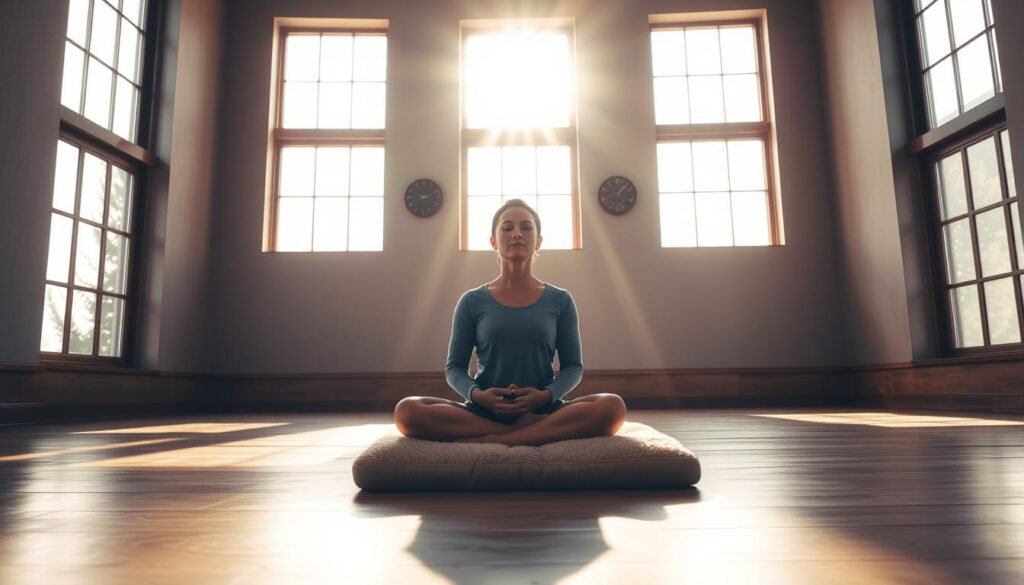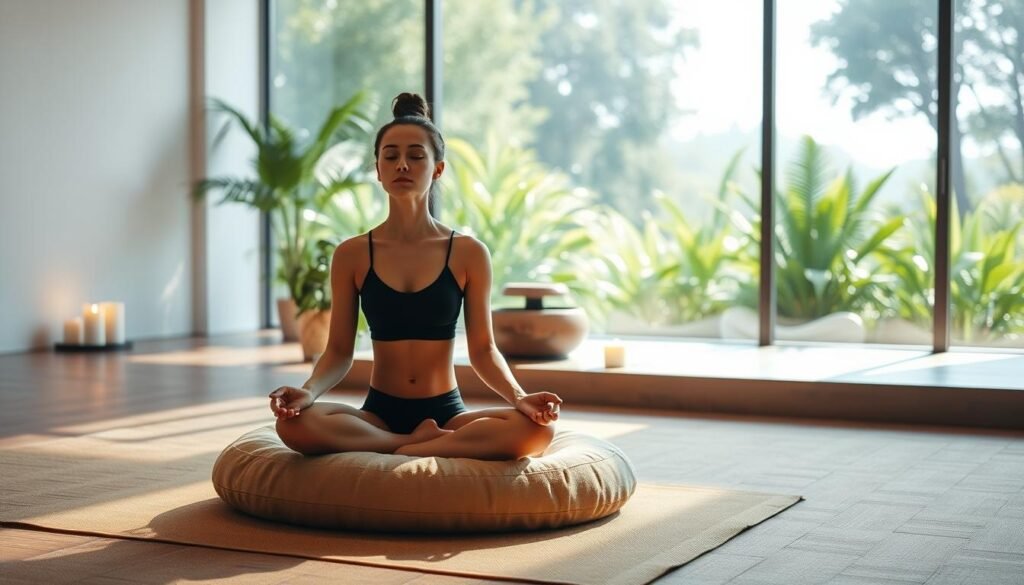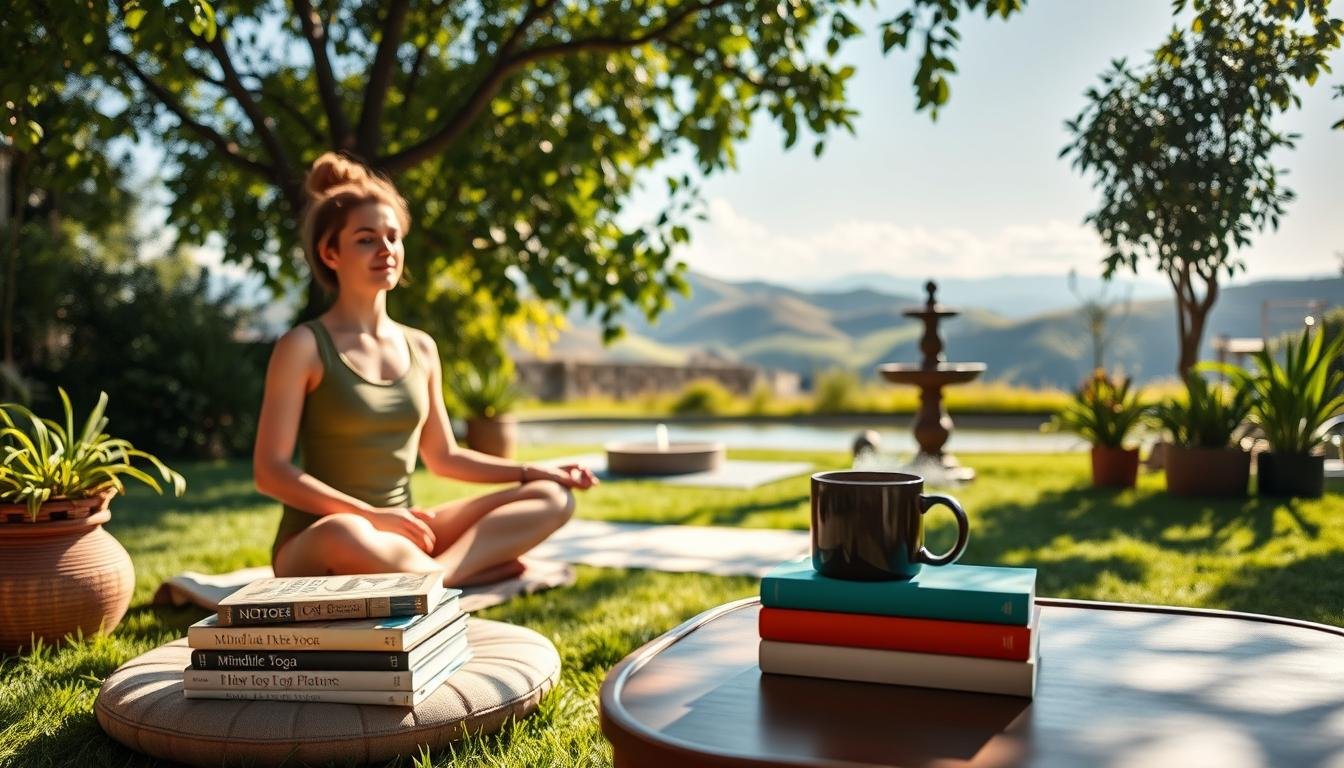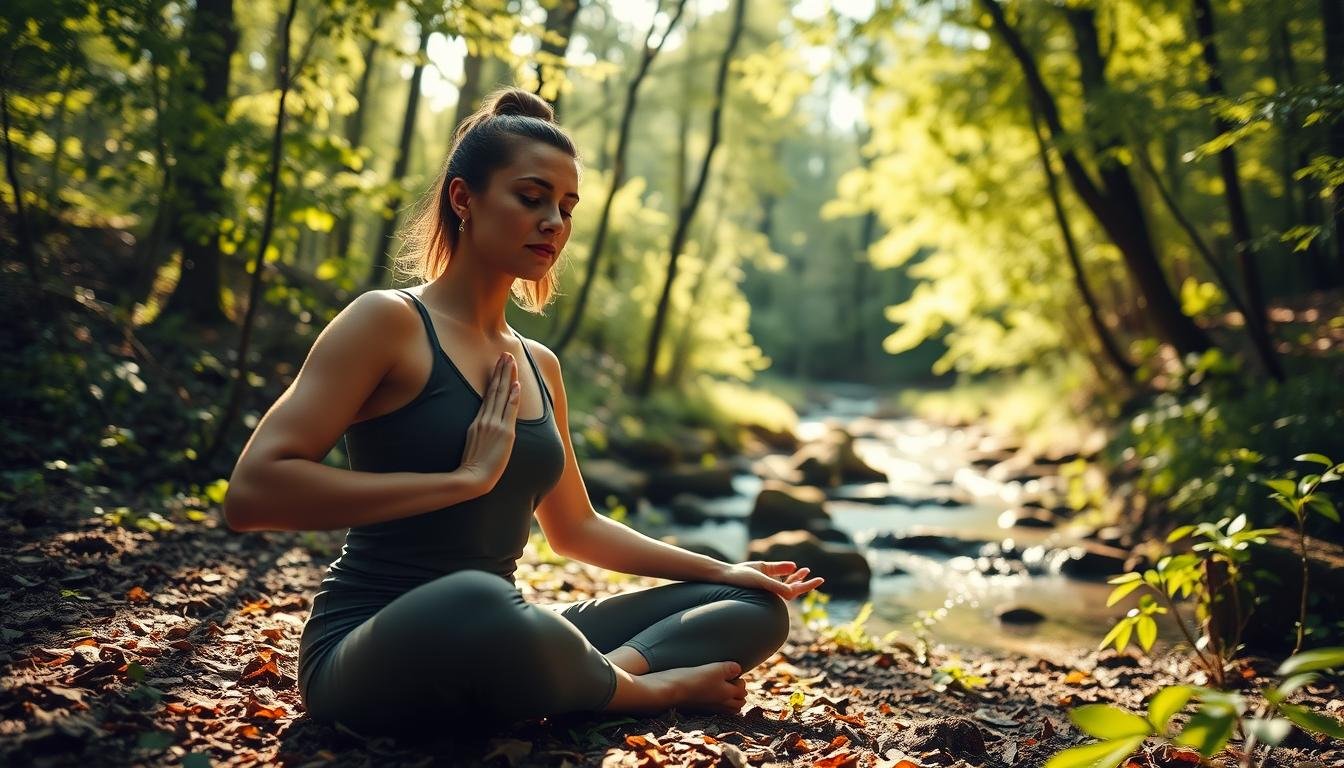Discover the transformative power of meditation and cultivate inner peace, even with a busy lifestyle. In today’s fast-paced world, it’s easy to get caught up in the hustle and bustle. However, incorporating meditation into your daily routine can have a profound impact on both mental and physical well-being.
By dedicating a few minutes each day to meditation, you can reduce stress, improve focus, and enhance overall mental clarity. Our comprehensive guide will walk you through the basics of meditation. It will provide you with the tools and techniques necessary to establish a consistent practice, even if you’re new to meditation or have a hectic schedule.
Key Takeaways
- Reduce stress and anxiety through mindfulness meditation
- Improve focus and concentration with regular practice
- Enhance overall mental well-being and inner peace
- Develop a greater sense of self-awareness and emotional regulation
- Boost cognitive function and memory
Understanding Meditation: What Is It?
Meditation is a practice that trains your mind to focus and relax. It helps you become more aware of your thoughts, emotions, and the present moment. It’s about gaining a deeper understanding of yourself and the world.
The Basics of Meditation
Meditation basics involve focusing on something specific to achieve a calm state. You can use your breath, a mantra, or a visualization to do this. It calms your mind, reduces mental chatter, and increases awareness of the present.
Different Forms of Meditation
There are many meditation forms, each with its own benefits. Mindfulness meditation focuses on your thoughts, emotions, and physical sensations. Loving-kindness meditation aims to cultivate compassion and kindness towards yourself and others.
The Benefits of Meditation for Busy Individuals
Busy people often forget about their mental health. Meditation can change that by reducing stress and boosting focus. In today’s world, it’s hard to find time for ourselves. But, adding meditation to our daily routine can greatly improve our health.
Reducing Stress and Anxiety
Meditation is great for lowering stress and anxiety. It helps us focus on the now and calm our minds. Regular meditation can also lower stress hormones, making us feel more at peace.
Here are some stress relief tips:
- Start your day with a short meditation
- Use deep breathing to calm your mind
- Try progressive muscle relaxation to release tension
Enhancing Focus and Productivity
Meditation also boosts focus and productivity. It trains our minds to stay present, helping us concentrate better. This makes us more efficient in work and life.
Studies show meditation improves attention and reduces distractions. It also sharpens our memory and problem-solving skills.
Promoting Emotional Well-Being
Meditation also improves emotional health. It helps us understand our thoughts and feelings better. This leads to higher self-esteem and emotional intelligence.
It also fosters compassion and empathy. This makes our relationships better and helps us connect with others more deeply.
Common Misconceptions About Meditation
## Common Misconceptions About Meditation
### Meditation Is Only for Yogis
Many think meditation is just for yogis or those with a certain background. But meditation is for everyone. It offers many techniques to fit different needs and likes. By learning about meditation, anyone can find inner peace and well-being.
### I Don’t Have Time to Meditate
People often think meditation takes a lot of time. But, you can fit meditation into a busy schedule. Even a few minutes a day can help, and there are many ways to make it part of your routine.
### You Must Clear Your Mind Completely
Another myth is that you need a completely empty mind for meditation. But, meditation is about being aware and focused. It’s about watching your thoughts and feelings without judgment, helping you understand yourself better.
By clearing up these myths, meditation becomes more welcoming to everyone. It’s a great way to reduce stress, improve focus, and boost well-being, no matter who you are.
In conclusion, by debunking these myths, we create a more welcoming space for meditation. This way, we can all find peace and well-being through meditation, making it a valuable part of our lives.
How to Create a Quiet Space for Meditation
Creating a quiet and comfy meditation area can really help your practice. A well-thought-out space not only deepens your meditation but also becomes a place for relaxation and mindfulness.
Finding Your Ideal Meditation Spot
Finding the perfect spot for meditation is key. Look for a quiet, distraction-free area. It could be a bedroom corner, a garden spot, or a peaceful office area. The goal is to find a spot where you can sit comfortably without interruptions.
Think about the space’s ambiance too. Soft lights, calm colors, and comfy temperatures create a peaceful vibe. As relaxation techniques become part of your daily life, having a dedicated space really helps.
“The key to meditation is not to fight off thoughts or feelings, but to create a space where they can arise without overwhelming you.”
Removing Distractions from Your Environment
After finding your ideal spot, the next step is to reduce distractions. Start by turning off or silencing any electronic devices that might interrupt. This includes phone notifications or using a device for calming sounds to block out background noise.
Also, declutter the space. A tidy area reduces visual distractions and promotes calm. Adding elements like plants, calming art, or a water feature can also help.
- Use soft, calming colors for the walls and decor.
- Incorporate comfortable seating or a meditation cushion.
- Minimize clutter and keep the space tidy.
- Consider using aromatherapy or calming scents.
By carefully designing your meditation space and using effective relaxation techniques, you can greatly improve your meditation. A well-designed space becomes a peaceful retreat from daily stress, helping you find inner peace.
Simple Meditation Techniques for Beginners
Simple meditation techniques can lead to a more mindful and peaceful life. Even the busiest people can benefit. It helps reduce stress and boosts focus.
Beginners can try different techniques to find what suits them best. The goal is to make meditation a regular part of your life.
Mindfulness Meditations
Mindfulness meditations focus on the present moment. You might pay attention to your breath, body, or senses. It teaches you to be aware and accept things as they are, without judgment.
- Focus on your breath, noticing its texture, temperature, and sensation as it moves in and out of the body.
- When your mind wanders, gently bring your attention back to the chosen focus without getting caught up in thoughts.
- Practice mindfulness in daily activities like eating or walking to enhance your ability to stay present.
Breathing Exercises
Breathing exercises are key in meditation. They calm the mind and help manage stress. Diaphragmatic breathing is especially effective.
To practice diaphragmatic breathing:
- Sit comfortably with your back straight, placing one hand on your belly and the other on your chest.
- Inhale deeply through your nose, allowing your belly to rise as your diaphragm descends.
- Exhale slowly through your mouth, feeling your belly fall as your diaphragm rises.
Guided Meditations
Guided meditations follow a guide’s voice through a meditation. They help beginners stay focused and know where to start. They cover topics like relaxation, stress relief, focus, and motivation.
There are many guided meditations available through apps and online. Find what interests you and suits your needs.
- Explore different guides and styles to find what resonates with you.
- Use headphones to enhance your experience and minimize distractions.
- Start with short sessions and gradually increase the duration as you become more comfortable with the practice.
Adding these simple meditation techniques to your daily routine can improve your mental wellness. It can lead to a more balanced life.
Incorporating Meditation into a Busy Schedule
Meditation isn’t just for those with lots of free time. It’s for anyone, even the busiest. With a few simple strategies, you can add meditation to your daily routine, no matter how hectic your schedule is.
Short Meditation Sessions
Many think meditation needs a lot of time. But, short meditation sessions can be very helpful. Starting with just a few minutes a day can make a big difference. For example, taking 5-10 minutes in the morning can set a positive tone for the day.
- Begin with deep breathing exercises to calm the mind.
- Use a guided meditation app to keep you focused.
- Practice mindfulness by paying attention to your surroundings.
Using Technology for Meditation
Technology can help you meditate even when you’re busy. There are many meditation apps that offer guided sessions, timers, and tracking features. Headspace and Calm are popular choices for beginners and experienced meditators.
“The mind is everything; what you think, you become.” – Buddha
Making Meditation a Daily Habit
To make meditation a daily habit, you need to be consistent. It’s important to incorporate it into your routine in a way that feels sustainable. This might mean meditating at the same time every day, like in the morning or before bed.
- Choose a specific time and place for meditation each day.
- Start small and gradually increase your meditation time.
- Be patient with yourself; developing a new habit takes time.
By doing short meditation sessions, using technology, and making it a daily habit, even the busiest can enjoy meditation’s benefits. Remember, the goal is not to reach some mystical state. It’s to cultivate awareness and peace in your daily life.
Mindfulness: Staying Present Amidst Chaos
Mindfulness is a powerful tool that helps you stay present and focused, even when things get chaotic. By adding mindfulness to your daily life, you can feel less stressed and more at peace.
What Is Mindfulness?
Mindfulness means being fully in the moment and aware of your thoughts, feelings, and body. It helps you stay calm and clear, even when things are tough.
This practice comes from Buddhist meditation but is now used everywhere for its health benefits. It’s great for your mind and body.
Practicing Mindfulness in Daily Activities
You can practice mindfulness in many parts of your day, like eating, walking, or even doing chores. The goal is to focus on what you’re doing, without getting distracted.
For example, when you eat, try to enjoy each bite. Notice the flavors, textures, and smells. It makes eating better and helps you eat healthier.

| Activity | Mindfulness Practice | Benefit |
|---|---|---|
| Eating | Savoring each bite, noticing flavors and textures | Enhanced dining experience, healthier eating habits |
| Walking | Paying attention to footfalls, surroundings | Increased sense of calm, greater awareness |
| Listening | Focusing on the speaker, tone, and context | Improved communication, deeper understanding |
Adding mindfulness to your daily life can change your life for the better. It brings more peace and strength to your inner self.
Overcoming Challenges and Distractions
Meditation comes with its own set of hurdles, like a wandering mind and tight schedules. This section will tackle these issues head-on. It will share tips on managing time well and keeping focus during meditation.
Dealing with a Wandering Mind
One big hurdle in meditation is a mind that wanders. It’s easy for thoughts about work or outside noises to pull you away. To beat this, learning mindfulness is key.
Time Management Strategies for Busy Lives
For those with packed schedules, finding time for meditation can be tough. Here are some ways to fit meditation into your day:
- Schedule Meditation: Make meditation a must-do part of your day, like brushing your teeth.
- Start Small: Begin with short sessions to ease into it.
- Make it a Habit: Stick to it every day.
- Use Reminders: Set alarms to remember to meditate.
- Incorporate Mindfulness into Daily Activities: You can meditate while doing everyday tasks.
Meditation Resources for Beginners
This section will help you find the right tools for starting your meditation journey. We’ll look at meditation apps, books, and online courses. These resources can help you build a strong meditation practice.
Apps to Aid Your Meditation Journey
Today, many meditation apps can guide you. Here are some top picks:
- Headspace: Offers personalized meditation sessions based on your goals and needs.
- Calm: Provides guided meditation sessions and sleep stories to help you relax.
- Insight Timer: Offers a wide range of free guided meditations and tracks your progress.
- Buddhify: Allows you to create custom meditation sessions based on your preferences.
- Meditation Studio: Provides a variety of guided meditations and customizable sessions.
These apps are a great way to start your meditation journey. They offer guided sessions and features to help you stay consistent.
Books and Online Courses
There are also many books and online courses to enhance your meditation practice:
- “The Miracle of Mindfulness” by Thich Nhat Hanh: A comprehensive guide to mindfulness and meditation.
- “Wherever You Go, There You Are” by Jon Kabat-Zinn: Explores the concept of mindfulness and its application in daily life.
- Online courses on platforms like Coursera, Udemy, and edX: Offer a wide range of courses on mindfulness, meditation, and related topics.
These resources can deepen your understanding of meditation and mindfulness. They help you build a more consistent and effective practice.
Cultivating Inner Peace Through Meditation
Meditation is a journey that changes lives by bringing calm and relaxation. In today’s busy world, finding inner peace can seem hard. But, regular meditation helps people stay calm and strong, making life’s challenges easier.
Understanding Inner Peace
Inner peace is more than a feeling; it’s a deep state of calm and contentment. It means being present, without worries about the past or future. The Dalai Lama once said,
“Peace is the only battle worth waging.”
This shows how vital inner peace is in our lives.
Meditation is key to finding inner peace. It helps quiet the mind and connect with our inner selves. Regular meditation brings peace, even when things are chaotic.

The Role of Gratitude in Meditation
Gratitude boosts meditation’s benefits, making inner peace deeper. It helps focus on what we have, not what’s missing. This makes us more positive and thankful.
Gratitude in meditation is simple. Just think of things you’re thankful for, like a good coffee or a supportive friend. This helps us see challenges differently and stay optimistic, improving our mental health.
Adding gratitude to meditation makes us more relaxed and less stressed. Being present and thankful improves our well-being a lot.
Additional Practices to Enhance Your Meditation
To make your meditation better, try yoga, stretching, journaling, and reflection. These practices can help you relax and find inner peace.
Yoga and Stretching
Yoga and stretching mix physical poses, breathing, and meditation. They help you feel calm and relaxed. Regular practice can also lower stress, improve flexibility, and boost your health.
Journaling and Reflection Sessions
Journaling and reflection can deepen your meditation. Writing down your thoughts and feelings helps you understand yourself better. It also improves your meditation practice.
Conclusion: Embracing Your Meditation Journey
Starting your meditation practice is a big step towards a more mindful life. It might seem tough at first, but keep going. Soon, you’ll see how meditation can reduce stress and boost focus.
Achieving Milestones
It’s important to celebrate your small wins. Maybe you meditated every day for a week or found a quiet spot. These achievements will keep you motivated on your meditation path.
Long-Term Benefits
The benefits of meditation last a long time. It can change your mental and emotional health for the better. By making meditation a part of your day, you’ll face life’s ups and downs with ease and calm.



